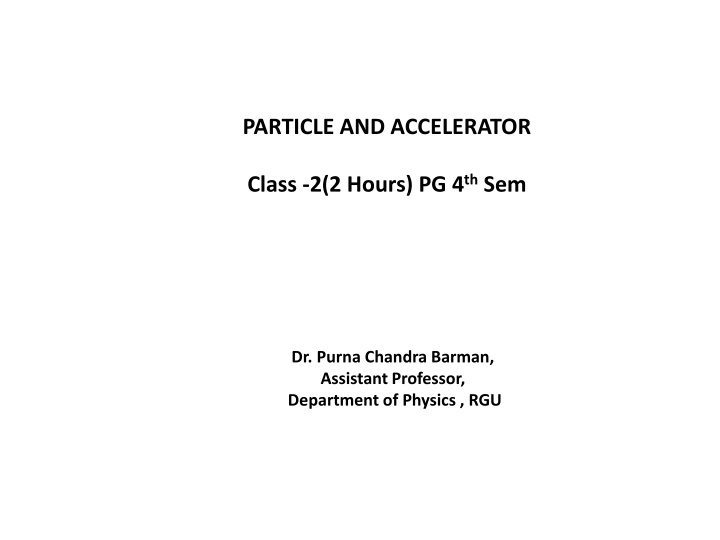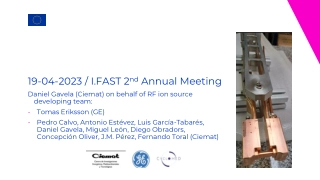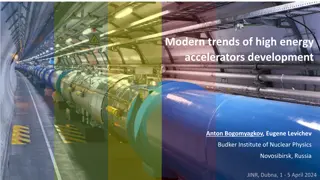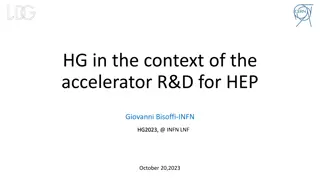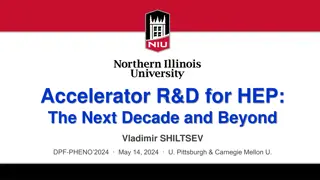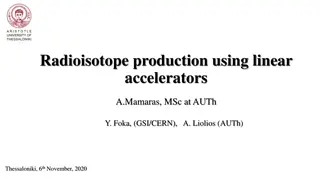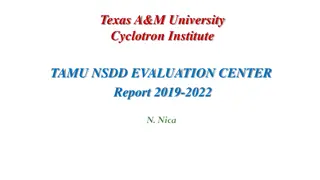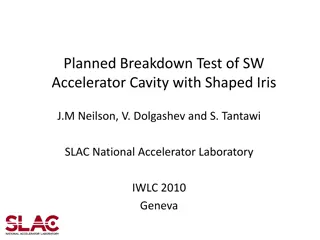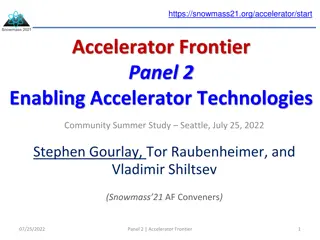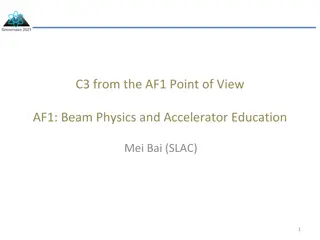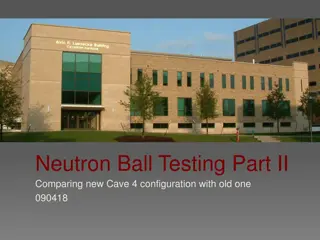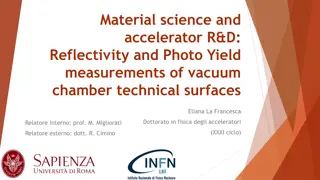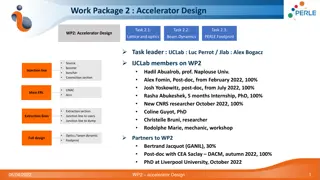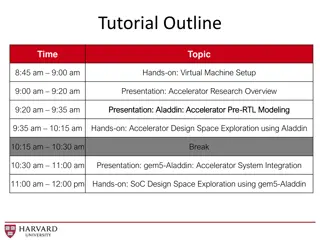Accelerator Technologies: Cyclotron, Synchrocyclotron, and Synchrotron
The cyclotron, synchrocyclotron, and synchrotron are accelerator technologies that utilize magnetic and radiofrequency fields to accelerate particles to high energies. The cyclotron accelerates particles in circular paths, whereas the synchrocyclotron and synchrotron adjust magnetic fields and frequencies to maintain particle orbits. Energy limitations and considerations for maximizing particle acceleration are discussed.
Download Presentation

Please find below an Image/Link to download the presentation.
The content on the website is provided AS IS for your information and personal use only. It may not be sold, licensed, or shared on other websites without obtaining consent from the author.If you encounter any issues during the download, it is possible that the publisher has removed the file from their server.
You are allowed to download the files provided on this website for personal or commercial use, subject to the condition that they are used lawfully. All files are the property of their respective owners.
The content on the website is provided AS IS for your information and personal use only. It may not be sold, licensed, or shared on other websites without obtaining consent from the author.
E N D
Presentation Transcript
PARTICLE AND ACCELERATOR Class -2(2 Hours) PG 4th Sem Dr. Purna Chandra Barman, Assistant Professor, Department of Physics , RGU
The cyclotron basically consists of two hollow, semicircular metal boxes , the dees , separated along their straight edges by a small gap. An ion source at the center of the gap injects particle charge Ze into one of the dees. A uniform and constant magnetic field is applied perpendicular to the dees, causing the particles to orbit in circular paths of radius r given by The particles of particles are accelerated each time it crosses the gap by a radiofrequency electric field applied across the gap of angular frequency, .
the angular frequency of revolution of the particles. As wp is independent of the orbit radius r, the particles always take the same time to cover the distance between two successive crossings, arriving at the gap each time at the proper phase to be accelerated. An upper limit in the energy attainable in the cyclotron is imposed by the relativistic increase of mass accompanying increase of energy, which causes them to reach the accelerating gap progressively later, to finally fall out of resonance with the rf field and be no longer accelerated . In the synchrocyclotron, this basic limitation on the maximum energy attainable is overcome by varying the frequency of the rf field, reducing it step by step in keeping with the decrease of wp due to relativistic mass change. While in principle there is no limit to the attainable energy in the synchrocyclotron, the magnet required to provide the magnetic field, which covers the entire area of the orbits, has a weight proportional to the third power of the maximum energy. The weight and cost of the magnet in practice limit the maximum attainable energy.
In the synchrotron the particles are kept in an almost circular orbit of a fixed radius between the poles of a magnet annular in shape, which provides a magnetic field increasing in step with the momentum of the particles. Accelerating fields are provided by one or more rf stations at points on the magnetic ring, the rf frequency increasing in step with the increasing velocity of the particles. The highest energy attainable is limited by the radiation loss of the particles, which on account of the centripetal acceleration radiate electromagnetic radiation at a rate proportional to the fourth power of energy. . motion of the particle d/ dt(mv) = eE + ev B
Comparing the three types of accelerators, we note that for the cyclotron both the magnitude of the magnetic field and the frequency of the rf field are constant. For the synchrocyclotron, the magnitude of the magnetic field is constant while the frequency of the rf field changes synchronously with the particle energy, and the orbit of a particle is still a spiral. For the synchrotron, both the magnitude of the magnetic field and the frequency of the rf field are to be tuned to keep the particles in a fixed orbit. In the cyclotron, as the energy of the particle increases, the radius of its orbit also increases and the accelerating phase of the particle changes constantly. When the kinetic energy of the particle is near to its rest energy, the accumulated phase difference can be quite large, and finally the particle will fall in the decelerating range of the radio frequency field when it reaches the gap between the D-shaped electrorodes. Then the energy of the particle cannot be further increased. The rest mass of the proton is 1 GeV. To accelerate it to 2 GeV with a cyclotron, we have to accomplish this before it falls in the decelerating range. The voltage required is too high in practice.
In the synchrotron the phase-shift probem does not arise, so the particle can be accelerated to a much higher energy. However at high energies, on account of the large centripetal acceleration the particle will radiate electromagnetic radiation, the synchrotron radiation, and lose energy, making the increase in energy per cycle negative. The higher the energy and the smaller the rest mass of a particle, the more intense is the synchrotron radiation. Obviously, when the loss of energy by synchrotron radiation is equal to the energy acquired from the accelerating field in the same interval of time, further acceleration is not possible.
Problem: A modern accelerator produces two counter-rotating proton beams which collide head-on. Each beam has 30 GeV protons. (a) What is the total energy of collision in the center-of-mass system? (a) The center-of-mass system is defined as the frame in which the total momentum of the colliding particles is zero. Thus for the colliding beams, the center-of-mass system (c.m.s.) is identical with the laboratory system. It follows that the total energy of collision in c.m.s. is 2Ep = 2 30 = 60 GeV
The Betatron Betatron is a device used for particle acceleration. We call the Betatron a type of particle accelerator that helps to accelerate the electrons with high speed in a circular orbit. To do so, it uses the electric field induced due to the alternating magnetic field. The term Betatron is derived from the beta-particles of highly energized electrons. This concept got originated by a scientist named Rolf Wider e. He developed the inductionaccelerator which got failed later. Betatron Oscillation The oscillation of particles in all circular accelerators about their equilibrium orbits is known as Betatron oscillation. In the horizontal and vertical planes, these oscillations are stable around the equilibrium orbit.
Betatron Accelerator A Betatron consists of a doughnut-shaped vacuum chamber surrounded by coils. The two ends of the coils are attached to an alternating voltage source. As a result, the coil produces an alternating magnetic field in a direction perpendicular to the doughnut-shaped vacuum chamber. The working principle of this device is dependent on two phenomena, such as: 1. Lorentz Magnetic Force 2. Electromagnetic Induction
Uses of Betatron Some of the applications of Betatron are mentioned below: 1. Betatron delivers about 300 MeV of highly energized beam electrons. 2. When the electron beam is required to strike on a metal plate, Betatron is used as X-rays and gamma rays source. 3. X-rays developed from Betatron have huge usage among industries and medical fields. 4. To study the applications of particle-physics, high energy of electrons is needed. 5. It can be a possible mechanism to learn about solar flare.
Limitations of Betatron Here are some lists that explain the limitations of betatron: 1. The maximum energy of the particle has an impact on the strength of the magnetic field. 2. The reason for declining in the magnetic field is the physical size of the magnet core and saturation of iron. 3. A betatron acts as a secondary coil of the transformer. 4. It helps to accelerate the electrons only in a vacuum. 5. The process of acceleration can only be conducted within a circular vacuum tube. 6. Betatron is functional under the conditions of the variable magnetic field and constant electric field.
